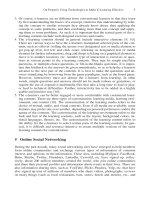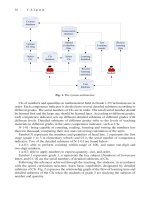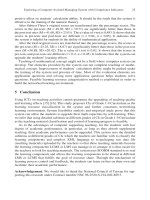Lecture Notes in Computer Science- P57 docx
Bạn đang xem bản rút gọn của tài liệu. Xem và tải ngay bản đầy đủ của tài liệu tại đây (567.27 KB, 5 trang )
Three Layered Thinking Model for Designing Web-Based Educational Games 269
Curriculum goal
Pedagogic Previous skill &
C Level Game goal Knowledge enhancement
O
N
T Design
E Level
X
T
Achievement M1.Pleasure M3.Skill enhance
Level M2.Challenge M4.Concentration
(4 Motivators to flow)
Game Style
Desi
g
n
Game Task
Desi
g
n
Game Interface
Design
Fig. 1. Three Layered Thinking Model of Web-based Educational Game Design
4 Validating the Model
In order to explain how the above model is useful in developing of educational games,
three games were evaluated. We illustrated the expert review results followed with the
survey from the learners.
4.1 Profile of Learners/Students
The subjects consisted of 120 undergraduate students who had been taking an infor-
mation literacy course provided to all students who are non-management information
systems majors. Some 53% of the subjects were male while 47% were female; around
3% of the subjects were freshmen, 26% were sophomores, 37% were juniors and 34%
were seniors.
4.2 Game Style, Task and Interface Design
The games were developed by a team of researchers and designers for the Web-based
course “Introduction of Software Applications”. The Web site is located at
and is accessible with passwords. The first game
was a simulation of how components are installed into a motherboard of a personal
computer (PC), as shown in Figure 2 (a). Research has indicated that some novice
users believed that the insides of a computer were bunches of wires connected to-
gether in a mass tangle. The purpose of this game was to increase students’ under-
standing of the shape and position of all components inside the shell of a PC.
The second game was a diagnosis of the components required for a PC purchase.
The purpose of this game was to increase students’ understanding of how to buy a
new PC based on their needs. Suggestions on the requirements of the necessary PC
components were given as feedback to the learner after a series Q & A regarding the
user’s purpose, preference and budget. The third type of game was designed to en-
hance players’ memory of operational procedures through stories. Many students are
270 F L. Fu and S C. Yu
Game1. Installation of
mother board (a)
Game2.
Suggestions of
PC Components (b)
Game3.
Manipulations of
Windows XP (c)
Fig. 2. Demonstration of game interfaces
interested in knowing more about problem-solving issues with regards to computer
operating systems, including deleting cookies, rearranging hard disks, reinstalling
software, and so forth. However, the steps involved in these tasks are difficult to re-
member for rookie users. The games were thus designed to associate the procedures
with a play serial dotted with quiet animators and light, and humorous conversations
on a battle against crimes in a big city. The “big city” is akin to the operating system
(Window XP) in a computer. The “crimes” are problems with computer usage, such
as a kidnapping of the home page. Each scene in the story is displayed on the right
side while corresponding problem-solving procedures are shown in a screen on the
left part, as demonstrated in Figure 2 (c). After the player performs the correct proce-
dure, he/she can click on an “arrow” to continue reading the next scene.
4.3 Skill Enhancement Design
The following expert reviews were through subjective ratings. For each goal, all
games were assigned a numerical value between one and five, indicating the extent to
which the games supported that criterion. Values from one to five indicate “not at
all,” “a little,” “average,” “good,” and “well done,” respectively.
Pedagogic considerations focus on whether the curriculum goals are attainable by
means of game goals, and whether the game style matches the knowledge taxonomy.
The goals of Game 1 and 3 were rates to fit better their respective curricula goals than
Game 2 because skills in strategic thinking are more difficult than skills in memory or
recognition. Based on Bloom’s taxonomy of knowledge, the strategic thinking in-
volved in PC components combination (as targeted in Game 2) requires a higher level
of knowledge than the other games. The pedagogic method in the game designs in this
study was the experiential theory mentioned in [5] and [11]. The earliest, initial learn-
ing process in computer games is behavioral learning. Players learn by trial and error
as well as stimulus associations. When the basic rules of a game are understood, play-
ers start to think cognitively about how they should respond to a new situation and
actively update existing knowledge to fit the new things they are confronted with in
the game environment [13]. According to suggestions from Prensky [12], simulation
games provide content that help develop the player’s system of understanding, while
adventure games can improve the user’s development skills. Therefore the match
between knowledge and game style was rated to be good for Game 1 and 3. The
Three Layered Thinking Model for Designing Web-Based Educational Games 271
puzzle game, which was the game style of Game 2, was suggested to fit best with the
learning goal of strategic reasoning [12].
4.4 Challenge Design
The games create scenarios and provide challenges to invoke the learners’ curiosity
and keep them involved. Players immerse themselves in the game when the challenge
provided by the game matches the skills they have [8]. If the challenge in the game is
higher than the player’s skill, he/she will become anxious. If the challenge of the
game is beneath the skill level of the player, then the player will become bored. Both
situations impede progress [8]. We evaluated challenges provided in the games ac-
cording to how well these problems are structured and how closely they match the
players’ skills. There were fixed solutions and procedures in both the installation of a
motherboard and the manipulation of Windows. The skill required in Game 1 was to
recognize the positions of each component through trial and error. In the game that
involves the manipulation of an operation system, the skill called for was to remem-
ber the sequence of procedures that solve a problem. As the games were offered in an
introduction to computers course, we assumed that these challenges matched the
players’ skills. The problem provided in Game 2 was considered to be too easy in
terms of how much it challenged players’ skills.
4.5 Pleasure Design
All three games were single-player games that provide for interaction only with the
software. There are two arguments concerning action-based drill and practice games
such as Game 1. One point of view stipulates that in such games, players might
simply keep on experimenting with actions until their scores improve. However, such
behavior, based only on trial and error, may not bring about a higher level of
intelligence [8]. On the other hand, the feedback delivered through rewards or
punishments from the game indeed reinforces the stimuli and responses, and
facilitates the learning of some behaviors [13]. The physiological pleasure comes
from the graphics, sound, as well as the interaction with the systems. The
psychological pleasure comes from positive feedback, such as score and/or applause.
Both of the above satisfactions could encourage the player’s engagement in playing.
All components in Game 1 were designed to resemble the real objects as closely as
possible. Therefore, the physiological pleasure of the game to be rated “good”.
Positive feedback is available when the computer “applauds” the player when he/she
finishes the task of installation, so the psychological pleasure was rated “average”.
Game 2 was a conversation-like diagnosis complete with a coloful interface. We
rate the physiological pleasure as “average”. All the players could finish the task no
matter what their skills or backgrounds were. The game does not rate the player’s
performance. Therefore we see the psychological pleasure as lacking. Students
probably garnered more pleasure from Game 3 due to its dramatic storyline,
cartoonish characters and humorous dialogue. Therefore we rate the physiological
pleasure of Game 3 as “well done”. The psychological pleasure is assessed to be
average because players can finish the task simply by following the computer’s clear-
cut directions.
272 F L. Fu and S C. Yu
4.6 Concentration Design
The context factors involved in the design of educational games included the physical
environment, equipment, technical support personnel, and so forth [3, 5]. The level of
concentration is determined by the stimuli and the workload the game provided.
Storylines and activities are considered as the stimuli while heavy demands on the
player’s memory capacity are regarded as a high workload [15]. All the basic rules of
playing these three games are comprehended by the players without the need for tu-
tors to assist them [15]. The importance of the storyline to a game depends on the
complexity of the game [8]. Game 3 used a serial of adventure story to help learners
remember the procedures. The humorous stories were considered to help maintain
players’ concentration. Game 2 created several scenarios in terms of PC component
combinations. The scenarios themselves served as a small story. A serial of questions
and answers before the diagnosis in Game 2 created a discontinuous gap between the
facts and strategic results. The overly complicated screen design that showed both the
story and operation demo in Game 3 was also considered to be a factor hampering
players’ concentration.
4.7 Total Achievement on Educational Game
Four achievements on Web-based educational games were goal (M1), challenge
(M2), concentration (M3), and pleasure (M4). Total achievements on educational
game flow can be calculated as the average score on individual motivators (Si)
multiplied by its weight (Wi) in the following formula:
Total Motivation =
Wi * Si
(1)
Game 2 and Game 3 were considered “good “for achieving players’ experience flow.
4.8 Survey on Learners’ Engagement
As suggested by [15], it is better to evaluate a game both by reviews of experts and by
the players’ engagement behaviors. The engagement data on games was collected
through system log file and a survey on the players. The users’ levels of engagement
were measured in terms of the length of time they spent on the game and how
Table 2. Empirical Results on Learners’ Engagement and Likeness
Three Layered Thinking Model for Designing Web-Based Educational Games 273
frequently they played the game. The empirical results of the measurements – the
frequency of play, time spent, and subjective rating of interest – are summarized in
Table 2. We found that learners who played Game 1 and 3 had higher frequency lev-
els than those who played Game 2. Also, while there was a high level of interest gen-
erated from Game 3, this was not the case for Game 1. The empirical result is consis-
tent with the results of our expert review.
5 Conclusions
Designing a Web-based educational game is a complicated task. One must consider
numerous factors such as rules, goals, experience flow, interaction, problem solving,
challenge, conflict, storyline, etc. Much effort exerted in the designing of educational
games should also be targeted at achieving the curriculum goal through relevant
learning theories, contexts and learners’ characteristics. The primary intention of this
paper is to present a three layered thinking model that makes designing and evaluating
Web-based educational games less complicated and more effective. This model
stresses the importance of focusing on the purposes in each step and their relation-
ships to achieve of skill enhancement, challenge, concentration and pleasure.
An empirical study was conducted to evaluate three games using the model. Cur-
riculum goals can be reached using different game styles, game tasks and interfaces
that produce separate results in terms of the players’ perceived challenge, concentra-
tion, pleasure and developed skills. Empirical results on the players’ level of engage-
ment are consistent with the expert’s evaluation results. The weight average of the
four elements of game results can indeed predict the players’ engagement, while
pleasure is verified to predict the subjective rating of interest.
Due to the constraints imposed by the budget and the learning platform, the games
in the study were only one-player games. Currently, leisure, social games are very
popular online. We expect that in the future, this paper’s model can be further applied
in the development of Web-based educational games with multiple users.
References
1. Baumann, K., Thomas, B.: User Interface Design for Electronic Application, ch. 17. Tay-
lor & Francis Inc., New York (2001)
2. Bloom, B.S.: Bloom Taxonomy of educational objectives, Allyn and Bacon. Pearson Edu-
cation, Boston (1984)
3. Derntl, M., Hummel, K.A.: Modeling Context-Aware e-Learning Scenarios. In: Proceed-
ings of the 3rd Int’l Conf. on Pervasive Computing and Communications Workshops
(2005)
4. Foreman, J.: NEXT-Generation-education technology versus the lecture. EDUCAUSE
Review, 17–30 ( July/August 2003)
5. Freitas, S.D., Olive, M.: How can exploratory learning with games and simulations within
the curriculum be most effectively evaluated? Computer & Education 46, 249–264 (2006)
6. Fu, F.L., Chen, W., Wiu, C.F.: Investigating the interest of on-line learning. In: Proceeding
of E commerce and digital life conference, Taipei, Taiwan (March 2005)









